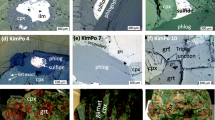Abstract
We report new field and petrographic observations, and mineral-chemical data, on the amphibolite-facies Buksefjorden and granulite-facies Nordland anorthosites, which occur in different tectonostratigraphic terranes within the Archaean gneiss complex of SW Greenland. The Buksefjorden body [from the Akulleq (middle) terrane] is dominated by plagioclase and Ca-amphibole, but shows widespread effects of retrograde hydration (epidote, chlorite). Most plagioclase compositions are in the An60–82 range, with the majority of samples showing average core compositions ∼An76, whereas rims or recrystallized margins are ∼An65. Most grains in the An70–82 range display optically visible Huttenlocher intergrowths. Amphiboles at Buksefjorden are mainly magnesio-hornblende with X Mg ranging from 0.70 to 0.45. The Nordland anorthosite [from the Akia (northern) terrane] is also dominated by plagioclase and Ca-amphibole, but contains additional clinopyroxene (∼Ca47Mg38Fe15) as well as minor orthopyroxene (∼En68), spinel and corundum. Plagioclase at Nordland shows an equilibrated, equigranular texture, consistent with prolonged slow cooling from high temperatures. Despite this textural equilibration, plagioclase at Nordland shows a striking range of compositions from An28 to An97, most of which is found in single thin sections. A distinctive feature is the presence of discrete anorthite (+ spinel ± corundum) domains in some samples. Although a number of explanations may apply, we consider these domains to result from prograde mass transfer reactions involving Ca-amphibole and plagioclase. Amphibole compositions at Nordland show similar X Mg to those at Buksefjorden, but are more aluminous, alkalic, and titanian. This shift to more pargasitic compositions is consistent with the contrasts in metamorphic grade between the two anorthosite bodies. At Buksefjorden, there is no correlation between the amount of modal Ca-amphibole and plagioclase composition, which would be expected if amphibole was produced solely through metamorphism. Our results suggest, alternatively, that the primary igneous mineralogy of these rocks may have been plagioclase (∼An76) + hornblende + pyroxene + magnetite. The primary mineralogy at Nordland is less certain, but it is noteworthy that no rocks contain anorthite of unambiguous igneous origin, in contrast to some other occurrences of Archaean anorthosites.
Similar content being viewed by others
Author information
Authors and Affiliations
Additional information
Received: 17 January 1996 / Accepted: 12 March 1997
Rights and permissions
About this article
Cite this article
Owens, B., Dymek, R. Comparative petrology of Archaean anorthosites in amphibolite and granulite facies terranes, SW Greenland. Contrib Mineral Petrol 128, 371–384 (1997). https://doi.org/10.1007/s004100050315
Issue Date:
DOI: https://doi.org/10.1007/s004100050315




